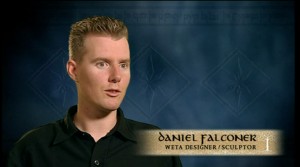
For the folks at Weta to be successful they need super talented people to help bring the world of The Lord of the Rings and The Hobbit to life. These folks are responsible for making the award-winning armor, weapons, costumes, and, of course, digital effects that have gained them so much acclaim. I thought for you all it would be great if we could sit down with one of these amazing individuals to find out what it’s like to help bring these worlds to life.
Well, Daniel Falconer one of the key artists at Weta has been kind enough to sit down and answer a few questions for everyone. As many of you may know Daniel been apart of amazing pieces like Bag End, Rivendell, Treebeard’s bust, and books like The Art of District 9. Having had a chance to own or see many of these pieces I was quite eager to sit down with Daniel and get his thoughts on being apart of helping Weta create these amazing things. After, reading this Q&A I would suggest to all the readers to get one of these great collectibles Daniel and Weta have created.
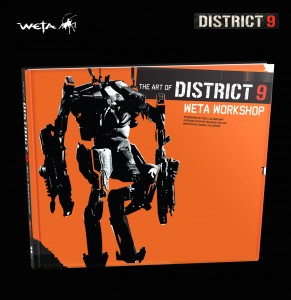
1. Daniel, you have written many books including The Crafting of Narnia, The Art of District 9, and The World of Kong. Did you find any of these books to be particularly challenging to write and do you have a personal favourite?
The Art of District 9 was more challenging in the sense that it required more research and interviewing than the other books, plus I was learning the publishing software as I went along, but certainly no less fun than any of the others. I have been very lucky that all the books I have helped put together for Weta have described subjects I am interested in and have a passion for, so in they have been easy to find the energy and drive to work on.
2. LOTR fans were recently treated to the unveiling of the breathtaking Rivendell environment. As the principle designer for the project did you feel any undue pressure knowing this particular environment was so highly regarded/anticipated by LOTR collectors?-AND-Were there any specific challenges Rivendell presented outside those normally encountered during the design and production of LOTR environments?
Absolutely! I think this is one environment that is very much beloved by fans and in the film it resides so sublimely in its 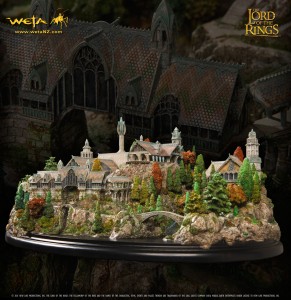 location amid the falls and sheer cliffs that removing it from that context and presenting it as a freestanding miniature was something I worried might result in something less appealing than the image of it that we all carry in our heads. Fortunately my fears were unfounded, as Alan Lee’s amazing architecture transcends the change in medium from film to polystone and looks just as magical on the shelf.
location amid the falls and sheer cliffs that removing it from that context and presenting it as a freestanding miniature was something I worried might result in something less appealing than the image of it that we all carry in our heads. Fortunately my fears were unfounded, as Alan Lee’s amazing architecture transcends the change in medium from film to polystone and looks just as magical on the shelf.
That’s not to say it wasn’t without other challenges – the research and reconciliation of sometimes conflicting source material was a challenge. Rivendell’s geography is represented somewhat fluidly in the films.
The toughest challenge was the actual making of the piece, but I got lucky and dodged all the hard work, just popping in with an opinion while the heavy lifting was done by all our amazing model makers and sculptors.
3. Included amongst your various job descriptions are copy writer, author, art designer, and illustrator. Is it safe to say your really are a ‘jack of all trades’ in regard to your employment with Weta Workshop?-AND-If you had to chose one specific aspect of your job you find most enjoyable/satisfying, which one would would it be?
I am very fortunate to work in a creative facility that isn’t tied exclusively to one medium. While Weta is first and foremost a special effects provider, as curious artists we have tried our hands at many other things as well, and with that has come the opportunity for someone like me to dabble in other interests as well as my film design work, writing being one of them, collectibles and toys being another, and IP development being something I am very passionate about. I wouldn’t describe myself as a jack of all trades as my skill set is fairly narrow compared to many at the Workshop, but I have very much enjoyed the opportunity to explore these other fields and help grow the company in new directions. It certainly makes every day even more interesting and helps keep the job fresh. There are days when I have no idea what it is I’ll be working on that day, but know it is almost certainly going to be hugely creatively rewarding.
4. Seeing as you fill so many roles with Weta Workshop, is there such a thing as a ‘normal’ day in the life of Daniel Falconer?
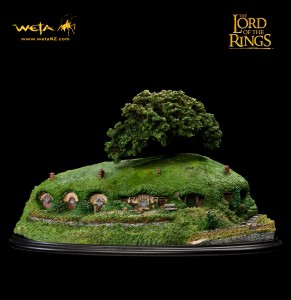
If anyone fortunate to have found a career in this industry can be truly said to have an ordinary day, I would say yes. My days typically start with an e-mail blast as I try to hit all the inbox essentials of the day, and then it’s straight into the project of the moment, which I usually try to restrict to just one a time because I often find it challenging to switch gears halfway through aday. Whether that’s a book I’m working on or a design for a film, I try to have a short term goal that I can achieve that day, be it a certain number of pages or getting my finished design into the drop folder in time for the deadline, which is usually late afternoon. The final couple of hours of the day often involve preparing for the next day’s project or making tweaks to my day’s work. Scattered throughout the day are usually a meeting or two – sometimes more. I try to restrict the number I have to attend because it can really break your artistic flow if you’re jumping up from your desk to run off to a meeting every hour or so.
Occasionally, I will also work late into the evening, but, being a family guy, I do my best to avoid this unless absolutely necessary as it means not seeing my children before they go to bed, and any parent knows that’s a good time to have both Mum and Dad on duty.
5. Daniel, you have had the opportunity to participate/contribute in many feature films including the LOTR trilogy, King Kong, The Chronicles of Narnia and The Lovely Bones. Is there any one film in which you are most pleased with your contribution?
Exploring Middle-earth remains an experience without peer for me, both then and now. I feel profoundly fortunate to have had the opportunity to be attached and influence the portrayal of this world that I hold so dear.
6. I have to say, The World of Kong : A Natural History of Skull Island was one of the most enjoyable ‘movie-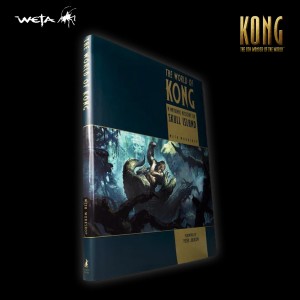 related’ books I have ever read. Just how daunting a task was it for you and the Weta design team to not only create an imaginary culture for King Kong, but an entire ecosystem as well?
related’ books I have ever read. Just how daunting a task was it for you and the Weta design team to not only create an imaginary culture for King Kong, but an entire ecosystem as well?
Thank you! I loved working on that movie and the book. The challenge of creating an ecosystem, or world-design as we like to call it at Weta, is really one that we embrace on every project, so in a sense that wasn’t any different for Kong than it had been for LOTR or Narnia, but getting to reproduce and expand upon that world in-universe was a real treat. Generally all that fictional lore only ever makes it out to audiences through the commentaries and supplementary materials on a DVD or perhaps the odd scrap in a making-of or art-of book. It was an absolute joy to be able to craft an entire book around exploring Kong’s island as if it were a real place and never having to break character to take a macro view. Essentially, it was a chance for us to just geek out in print the way we do in our own heads when we’re designing.
7. Daniel, if you could choose only one, who would you say is your favorite middle-earth character? And why is this particular character your favorite.
Treebread would be my pick, because I love what he stands for, how surprising the character is in the books and what fun the whole process of helping create him for the screen turned out to be.
8. Daniel, you’ve now done several pieces involving Lord of the Rings trilogy. What would you say has been your favorite piece to work on?
Any chance to go back to Middle-earth is a pleasurable one for me. Working on the films themselves was undoubtedly the highlight, but there have been other fun journeys into Tolkien’s realms as well, including creating the Decipher Inc. card game characters, writing descriptive copy for collectible box art and certainly helping art direct some of our Middle-earth themed 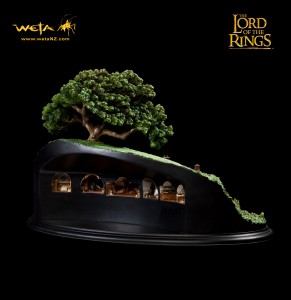 collectibles at Weta. It’d be hard to pick a favourite out of those, but I think anytime we’re creating something new and expanding the universe in some way, I’m at my happiest.
collectibles at Weta. It’d be hard to pick a favourite out of those, but I think anytime we’re creating something new and expanding the universe in some way, I’m at my happiest.
9. Following up with the last question. Is there a something you’ve not worked on yet that you would love to work on be it an environment, statue, shield, etc.
Well, following on from The Hobbit, a dream of mine would be to help design adaptations for some of Tolkien’s other Middle-earth stories. I’m rereading the Children of Hurin again at present and can’t help but imagine what an amazing film and collectibles line that story would yield, though I accept that is almost certainly never going to happen. A guy can dream, right?
10. Your knowledge of and appreciation for Middle-earth came through loud and clear in the DVD extras for the trilogy. Other than Treebeard, which character or design did you like most working on?
Thank you. The elves are a race that have always inspired and excited me, so anything elven was fun to be involved with, not least of all because I love the look of the Art Noveau movement and it became apparent very early on that it would be a strong influence on our Elven designs. I also really enjoyed helping to find our Easterlings, as theirs was a culture not all that visually defined in the literature. We had quite a bit of freedom to explore and seek out an interesting new look. It was also nice to create a villainous culture that wasn’t necessarily grundgy like the Orcs, but strutted about with some pride and style. I was pleased that Peter reacted so well to the designs that we all did as the direction he took them was one I really liked.
11. Daniel, you’ve done a lot of great work with armor with Lord of the Rings. Would you like to turn that into a collectible range for Weta?
That’s a notion we have certainly discussed in the past. It could be a natural extension of our miniature helmet line if done at a smaller scale, or it could be a fantastic thing to try and market as full size replicas. There’s a lot of enthusiasm for the idea at Weta, but so far we haven’t found the right way to do it. Maybe it’s something that will happen in the future? Of course then I’d have more stuff I’d have to buy too!
12. Daniel, could you tell us how you got your start with Weta and what is been like working there? 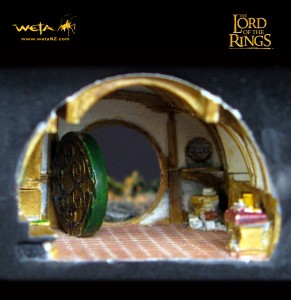
I was lucky enough to be in the right place at the right time to land a job at Weta. I had a passion for world and creature design that stemmed from growing up on the work so folks like George Lucas and Jim Henson. I attended art school where I studied Graphic Design and did my best to twist every assignment they gave us towards my interest in designing imaginary worlds, much to the dismay of some of my tutors who didn’t always appreciate that this might be a career path. It was certainly an unconventional one in little old New Zealand and indeed, I always imagined I’d have to head offshore eventually if I was serious about this pursuit.
Fortunately for me, Weta existed and, around the time I was studying, so did the Hercules and Xena television series, being filmed very close to where I lived. I had to seek some professional experience as a course requirement, so I pulled every string I could and managed to get a look inside where they were making the shows, spending a week with them learning the business. It was a life changing experience and in the course of it I met Weta boss Richard Taylor, quite by accident, who was providing creature effects to the show at the time. We hit it off immediately, having a shared passion, and despite not having any work on my person to show him at the time, he offered me a chance to visit Weta and spend a week with them to see if this industry was indeed going to be a good fit for me. Fifteen years later I am still here, so I guess it was!
I think there were a number of factors that played in my favour that day – one being my passion for this work and that even though I didn’t have anything I could show Richard that day, when I did get down to Weta and shared my portfolio with him, he could see that I was completely invested in world design already and had the right mindset for the kind of projects Weta did, being both energised by the genre, having at least a little ability and a diligent, self motivated attitude.
The second factor at play was Richard’s openness, without which I would never have gotten my break. That cannot be overstated. He created the opportunity for me and I seized it.
Finally, and not least of all, there was luck. The stars alligned to put me in the right place that fateful day. There are plenty of folks out there who are way more talented and have so much to offer, but may never get the chance because they missed their moment. Weta was a small company, relatively unknown, looking for young designers to swell its ranks, and on the cusp of emerging as a major player in the world’s film industry with LOTR just two years away when I met Richard. I got lucky, and I don’t deny it played a very important part in me being at Weta. It would have been much harder for me to get my chance had I been a few years later.
————–
We would like to thank Daniel, Magnus Hjert, Weta, members at Sideshow Freaks, and the Shadow and Flame for all helping this interview come together. We know all of you are busy but we truly thank you for your help.


